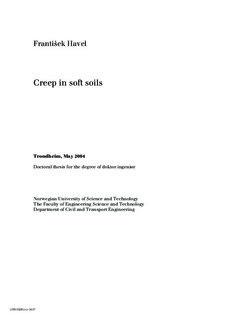| dc.description.abstract | As more and more constructions are concentrated in densely populated urban areas, there is an increasing need to construct buildings and geotechnical structures on soft clay materials, which usually produce significant creep deformation. Although a lot of research work has been related to the creep behaviour of a natural clay material, there are still many questions about this phenomenon. Even today, prediction of the time dependent deformation is generally very problematic. Detailed laboratory, in-situ and numerical studies of soft soil creep are necessary for the better understanding and consequently, better prognosis of this behaviour. All these studies were performed and will be presented in this thesis.
The long-term, one-dimensional consolidation has been investigated by oedometer tests on undisturbed Norwegian Kvenild quick clay, undisturbed Norwegian Glava clay, undisturbed and remolded Norwegian Onsøy clay and undisturbed Czech Terlicko clayey shale. All tests have been performed in an incremental loading oedometer apparatus with a lever arm, where, in the case of the Glava clay and the Terlicko clayey shale, two sizes of oedometer rings have been used. Detailed means of evaluating the stress-strain-time oedometer behaviour using a time resistance concept introduced by Professor Nilmar Janbu [46,48] is described. The application of the Soft-soil-creep model is presented. This is implemented in the geotechnical finite element program PLAXIS 8.1, for the mathematical modelling of the longterm oedometer test, with emphasis on the correct choice of the input parameters based on the oedometer test results, and their influence to the model’s behaviour.
The undrained and drained deviatoric creep behaviour of the Norwegian Glava clay and the Czech Terlicko clayey shale have been studied under triaxial compression. Two different triaxial apparatuses have been used in the study - standard triaxial apparatus made by Wille Geotechnik Gmbh and unique Creep Triaxial apparatus made at NTNU. A large number of undrained and drained deviatoric creep tests under different conditions have been carried out on 100x50 mm (1:2) and 50x50 mm (1:1) cylindrical specimens. Evaluation of the deviatoric creep behaviour based on the time resistance concept together with detailed description of tests conditions is reported. Data is presented showing the relation between stress level, i.e. degree of shear mobilisation at the start of the creep, time, pore pressure development and accumulated axial creep strain. Significant effort has been put into the study of the undrained triaxial tests on 1:1 clay specimens in general and undrained deviatoric creep triaxial tests on 1:1 clay specimens in particular. The problem connected with the pore pressure development and measurement is presented. A 2D numerical study of the undrained triaxial deviatoric creep tests has been done on 1:1 and 1:2 specimens using the finite element program PLAXIS 8.1. There is also a comparison of the laboratory and numerical behaviour.
Study of the viscosity and creep behaviour of a natural clay has been performed with modular compact rheometer. The MCR 300 rheometer has been used for the rheological investigation of the Norwegian Glava clay. Oscillatory, rotational and creep tests have been done with this apparatus. The basic characterisation of these tests is presented together with their evaluation. Deviatoric creep tests on modular compact rheometer have been evaluated based on the time resistance concept and compared with deviatoric creep tests on a standard triaxial apparatus. The analysis of the Czech Terlicko dam with emphasis on the creep behaviour has been performed based on the cooperation with the Povodi Odry, a.s., Czech Republic. A detailed investigation of the undisturbed clayey shale from the Terlicko dam substratum has been done in the geotechnical and geological laboratory. The characterisation of Terlicko clayey shale is reported base on the laboratory tests results. The in-situ behaviour of the Terlicko dam with emphasis to the uplift of the righthand slope hillside is described. In order to understand the in-situ behaviour a numerical study of the Terlicko dam has been done with PLAXIS 8.1 and Soft-soilcreep model. Results from this 2D numerical test together with recommendations and suggestions are presented. | nb_NO |
